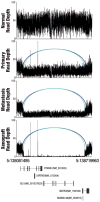Genome remodelling in a basal-like breast cancer metastasis and xenograft
- PMID: 20393555
- PMCID: PMC2872544
- DOI: 10.1038/nature08989
Genome remodelling in a basal-like breast cancer metastasis and xenograft
Abstract
Massively parallel DNA sequencing technologies provide an unprecedented ability to screen entire genomes for genetic changes associated with tumour progression. Here we describe the genomic analyses of four DNA samples from an African-American patient with basal-like breast cancer: peripheral blood, the primary tumour, a brain metastasis and a xenograft derived from the primary tumour. The metastasis contained two de novo mutations and a large deletion not present in the primary tumour, and was significantly enriched for 20 shared mutations. The xenograft retained all primary tumour mutations and displayed a mutation enrichment pattern that resembled the metastasis. Two overlapping large deletions, encompassing CTNNA1, were present in all three tumour samples. The differential mutation frequencies and structural variation patterns in metastasis and xenograft compared with the primary tumour indicate that secondary tumours may arise from a minority of cells within the primary tumour.
Figures




Comment in
-
Cancer: Genomics of metastasis.Nature. 2010 Apr 15;464(7291):989-90. doi: 10.1038/464989a. Nature. 2010. PMID: 20393550 No abstract available.
-
Metastasis: How do you spell metastasis?Nat Rev Cancer. 2010 Jun;10(6):384. doi: 10.1038/nrc2859. Nat Rev Cancer. 2010. PMID: 20509171 No abstract available.
-
Xenografts as models of clonal selection and acquired resistance to therapy.Clin Chem. 2015 May;61(5):769-70. doi: 10.1373/clinchem.2014.237289. Epub 2015 Mar 2. Clin Chem. 2015. PMID: 25733716 No abstract available.
References
-
- Carey LA, et al. Race, breast cancer subtypes, and survival in the Carolina Breast Cancer Study. JAMA. 2006;295(21):2492–2502. - PubMed
-
- Citron ML, et al. Randomized trial of dose-dense versus conventionally scheduled and sequential versus concurrent combination chemotherapy as postoperative adjuvant treatment of node-positive primary breast cancer: first report of Intergroup Trial C9741/Cancer and Leukemia Group B Trial 9741. J Clin Oncol. 2003;21(8):1431–1439. - PubMed
Publication types
MeSH terms
Substances
Grants and funding
LinkOut - more resources
Full Text Sources
Other Literature Sources
Medical
Molecular Biology Databases
Miscellaneous

